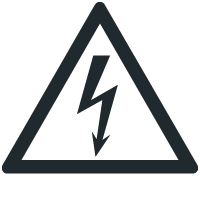Restrictions
- It is to be noted that if the drive does not have a mechanical brake or if the brake is defective, the drive may coast to a halt (depending on the friction and mass moment of inertia of the system). In the event of regenerative loads or with axes that are loaded with gravitational forces or driven externally, the drive can even accelerate. This must be taken into account in a risk assessment of the system/machine. Additional safety measures might have to be implemented (e.g. safety brake system).
- The drive unit cannot be used without an additional brake system for application-specific safety sub-functions that require active deceleration (braking) of the dangerous movement.
- When using the SS1-t function, the deceleration ramp of the drive is not monitored with respect to safety. In the case of a fault, the drive might not be decelerated during the delay time, or the drive can accelerate in the worst case. In this case, the safety-related deactivation via the STO function is only activated after the set delay time has passed. The resulting hazard must be taken into account in the risk assessment of the system/machine and may need to be covered through additional safety measures.
- The STO function cannot prevent a possible jerk or DC braking.




